I often help product teams move from reactive, stakeholder-driven ways of working to strategic, outcome-driven ways. In this process, I look for a simple way to visually connect those outcomes to the decisions we make. There are plenty of frameworks that can help you do this, such as the North Star metric, impact mapping, opportunity solution trees (OSTs), etc. They all try to achieve similar things.

The truth is, it’s not really about the framework. I personally lean on Michael Karpov’s hierarchy of metrics (for the business metric part) and Teresa Torres’ OSTs (for the product goals and customer opportunities parts) because they both offer a great way to visualize why we believe our choices will have the desired impact. It’s important not to get hung up on the framework, but to zoom out to the larger context.
I’m often asked for practical examples of what this visual process of connecting business goals to customer opportunities can look like. In this article, we’ll discuss just that and outline a concrete example for a “multi-aha” product.
Most companies I work with identify multiple aha moments for their users — the moment they first realize the value of the product. There are two instances of use cases your product can solve for customers and provide value:
The example dives into a sequential aha for a B2B SaaS product analytics tool, comparable to LogRocket.
The go-to market strategy is product-led growth, so users can enjoy a 30-day free trial.
New organizations must install a code snippet on the website to track events. After this, a short onboarding survey asks new users which of the above core actions they want to perform first.
Now, let’s use a specific example of a business goal as a framework for making product decisions. Our business goal will be to increase 30-day user retention.
The overarching business goal to increase 30-day user retention can be broken down into three distinct “gates:”
We now need to determine which of these gates is the most important to tackle first. Here’s where a combination of quantitative and qualitative data comes in handy:
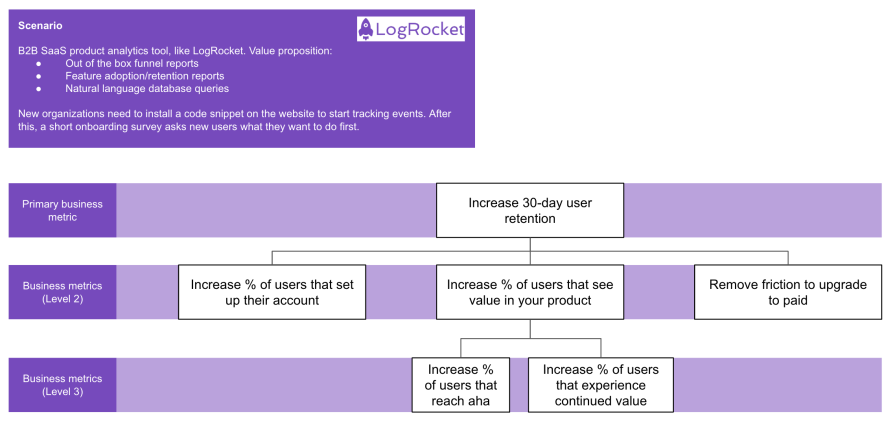
Funnel reports can help you see exactly where your users are dropping off in the flow. You can compare the metrics you find to industry benchmarks to check if you’re “healthy.”
Example funnel report:
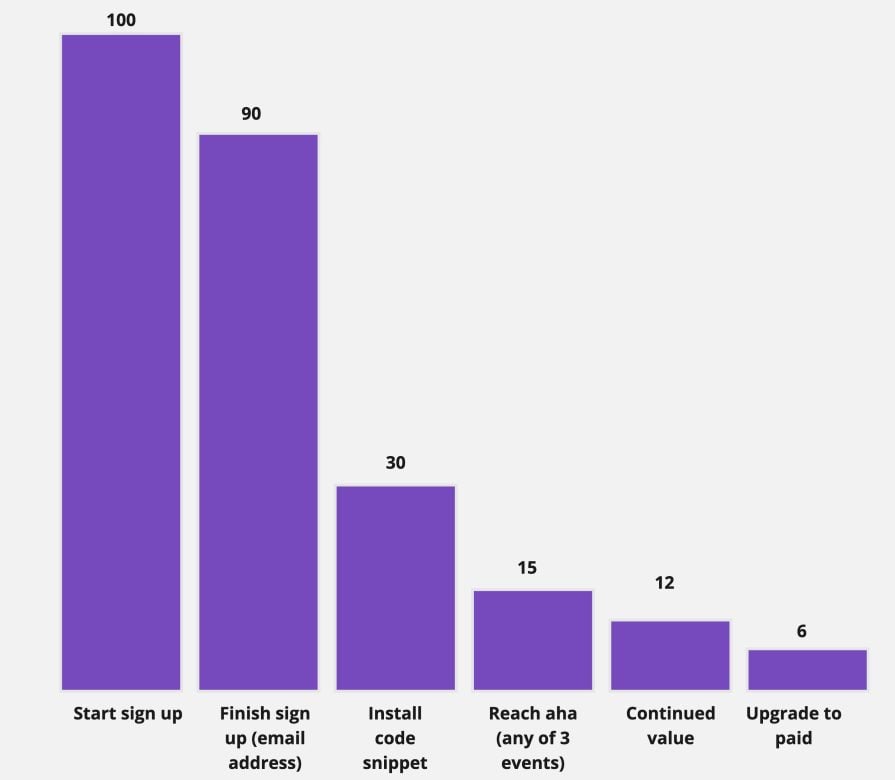
What becomes immediately apparent from looking at our chart is that only 30 percent of people take the step of installing the code snippet. This is a significant hurdle that has a significant impact on downstream metrics.
According to popular SaaS benchmarks, a good activation rate lies between 20–40 percent. An aha moment is usually seen as the first component of activation, followed by continued value (sometimes referred to as eureka and/or habit).
Our 15 percent sign-up to an aha conversion rate falls short. This poor rate results in a 6 percent free-to-paid conversion rate, far below the SaaS benchmark.
As a quick intermission, I could go on a rant against metrics benchmarks. Within the terms “SaaS” and “PLG” exist a wide range of industries, target customers or ICPs, red or blue oceans, problems to solve, etc. Just because two companies are both subscription- and cloud-based or allow users to try before they buy doesn’t mean they’re the same in any other way. As a result, they should not always adhere to the same benchmarks, though it’s helpful to have a statistic to compare to. I do use these benchmarks when I’m joining a new company and when the idea of measuring things is pretty new.
Next, say we shadow 10 non-customers as they sign up for our product for the first time. We watch them stumble through the steps and ask them to narrate their thoughts. Here we find a bunch of friction points at various steps of the user journey:
Account creation:
Code snippet:
Creating a report:
Running a natural language query:
We also look at session replays of new users to see which paths they take.
Based on this data, we decide that our primary focus will be increasing the percent of users that reach an aha. Our assumption is that by allowing users to try out the product without installing the code snippet, we can show them enough value to motivate them to install the snippet later in the customer journey:
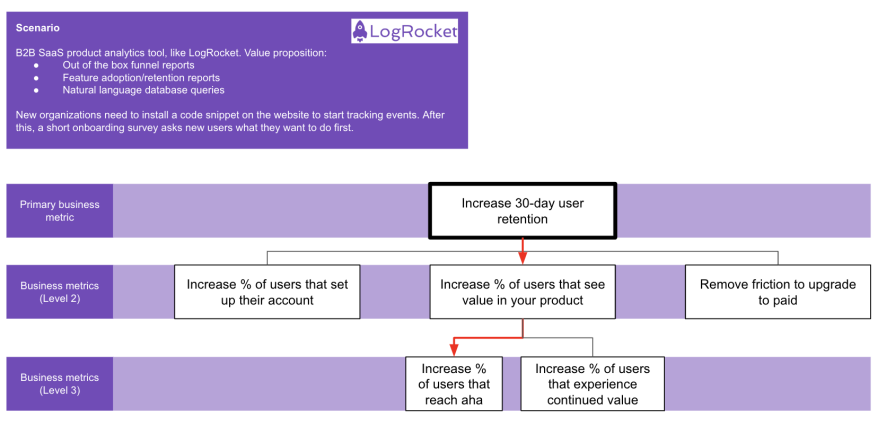
We follow the business metric branch “increase the percentage of users that reach aha.”
To split this metric into product goals, we need to understand which change in users’ behavior or sentiment shows that aha is reached.
For a multi-aha product, we might need to do some customer discovery to understand what our aha’s could be. In the case of our product analytics tool, there could be three primary aha’s leading to three product goals:
| Aha | Product goal |
| Create and save a funnel report* | Out of the segment that indicates they want to start with a funnel report, 80 percent should create and save a funnel report in their first session |
| Create and save a feature report* | Out of the segment that indicates they want to start with a feature report, 80 percent should create and save a feature report in their first session |
| Run a natural language query and save OR share the result with a team member* | Out of the segment that indicates they want to query the database, 80 percent should create a query and save or share the result |
* Just because a user has created a report or ran a query does not mean they were pleased with the result. A save or share action is a far stronger indicator. You could also ask for satisfaction with the specific feature with a one-question survey like, “Did you get useful insights from this report?”
We now decide which of these three potential Aha’s to focus on first.
You might think: why not just immediately move the code snippet requirement to later in the journey since this tackles all three aha’s?
For one, we don’t want to run with the first idea that pops into our head. Instead, we want to prioritize opportunities and compare multiple ideas against each other. This process doesn’t need to take longer than a week. We can prioritize opportunities based on the evidence we have available today and run a quick ideation session to make sure that the best ideas bubble to the top
Secondly, even if we decide to move the code snippet requirement, we still need to decide which aha we want to enable without code snippet installation first. By cutting our ideas as small as possible (instead of solving the problem for three aha’s at the time) we can adopt an agile development approach
We’ll combine the quantitative and qualitative data we have at our disposal
We decided to focus on the aha “I want to create a funnel report” first, with the corresponding product goal, “Out of the segment that indicates they want to start with a funnel report, 80 percent should create and save a funnel report in their first session:
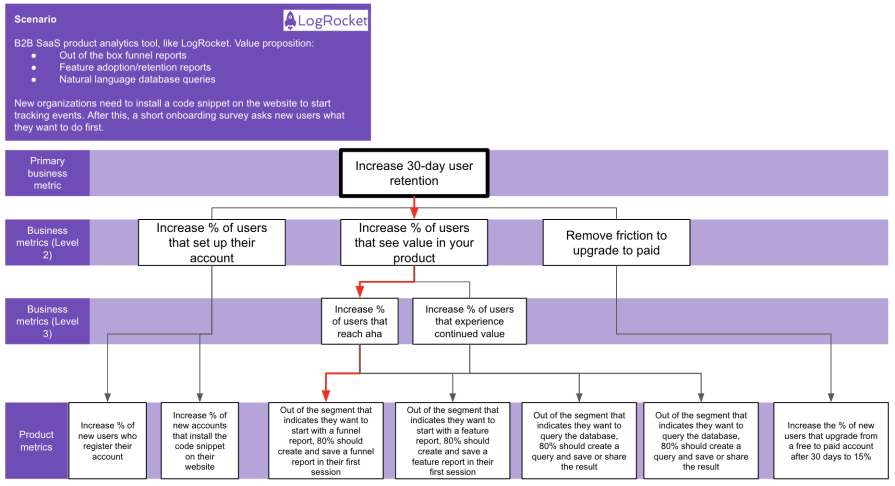
During our shadowing session, we already uncovered various customer needs, pain points, wishes, and desires (in Teresa Torres’ words, opportunities).
These are clustered underneath the moments in the user journey with their corresponding product goals:
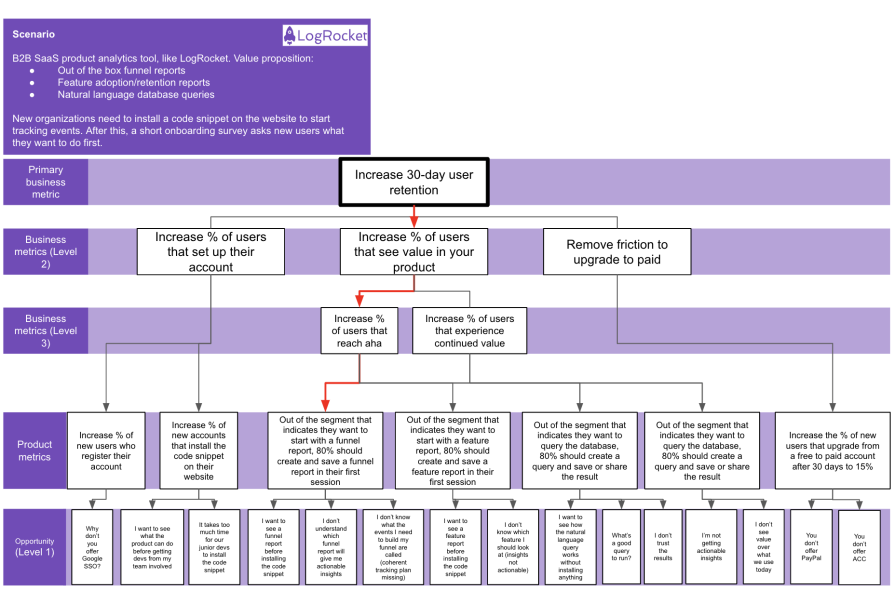
To reiterate, we’re only comparing the opportunities that are clustered under the product goal we landed on. This goal (out of the segment that indicates they want to start with a funnel report, 80 percent should create and save a funnel report in their first session) corresponds to our most important aha (creating a first funnel report).
Teresa Torres recommends factoring in four considerations when assessing opportunities:
In our case, we can quite quickly jump to the opportunity “I want to see a funnel report before installing the code snippet.” We’ve seen the overwhelming importance of this opportunity reflected in both our funnel report (quantitative) and our shadowing sessions (qualitative):
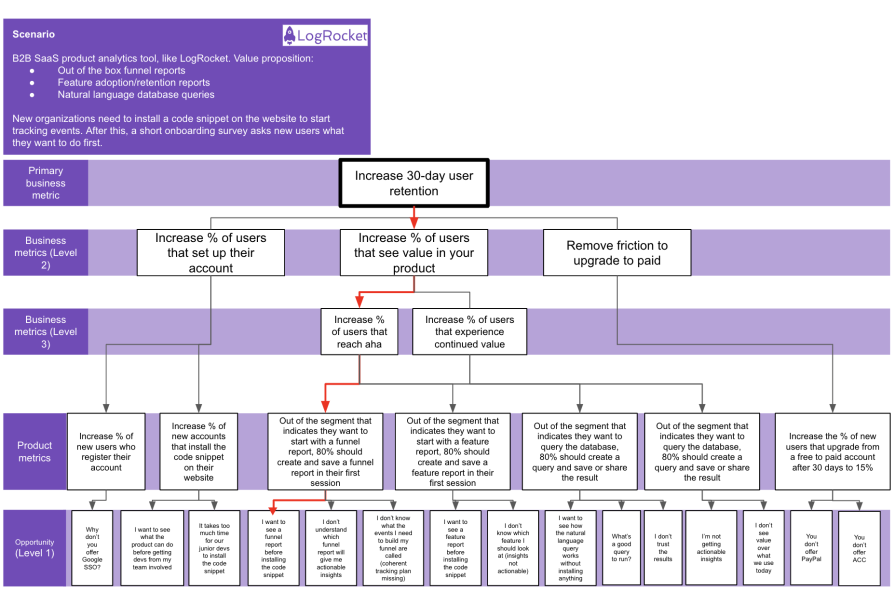
Below the selected opportunity will come multiple solution ideas, and under each solution idea come lightweight experiments, such as prototyping or A/B testing.
After testing and launching the idea that best addresses the opportunity “I want to see a funnel report before installing the code snippet,” product teams should make sure to measure over time:
I hope this helps you in your day-to-day work!

LogRocket identifies friction points in the user experience so you can make informed decisions about product and design changes that must happen to hit your goals.
With LogRocket, you can understand the scope of the issues affecting your product and prioritize the changes that need to be made. LogRocket simplifies workflows by allowing Engineering, Product, UX, and Design teams to work from the same data as you, eliminating any confusion about what needs to be done.
Get your teams on the same page — try LogRocket today.

Most teams fail at autonomy. Learn how clear rules help product teams move faster without micromanagement.

A practical framework for PMs to use AI in ideation without sacrificing judgment, strategy, or decision quality.

A practical five minute revenue estimation method to help product managers compare ideas, drop low impact features, and prioritize smarter.

A practical guide for PMs who want to stop being bottlenecks, delegate smarter, and lead teams effectively with a clear ownership framework.